Constantly looking to improve and diversify the outlets for recovered materials so that they can continue diverting material from landfills, even as markets change, Revolution Recovery is playing defense and looking for opportunities to jump on new technologies.
Jonathan Wybar, owner and founder of Revolution Recovery (Philadelphia, PA) started the company in 2004 with his former business partner, recycling debris from construction sites. It was the beginning of the green building movement and the LEED program was new and fresh and Wybar welcomed the C&D waste. With no prior experience, they hustled and worked hard to line up dumpster companies, wood and metal recyclers, write recycling reports and eventually started to gain some traction. Customers loved the services and started using Revolution Recovery on their future projects. The company rapidly started outgrowing their first site. Therefore, in 2005, Wybar rented a 4,000-foot side lot, sharing the space with a scrap metal recycler. “We started out small-scale, processing 20 tons per day, tipping the loads, and sorting the wood, cardboard, metal and drywall by hand. Then we hired one employee and purchased one truck, later growing to hire three employees. In 2008, we moved seven people up to our Northeast Philadelphia location, where we were tucked away on the back corner of the property. In 2010, we hired our first office employees, and took over the 3 ½ acre property,” says Wybar. By 2011, Revolution Recovery had put in a large sort line to automate the process and deal with increased volume. A couple of years later, they added in a shredder, a magnet, a trommel screen and air knives. He continues, “By that point we were processing more than 400 tons, had 40 to 50 employees, and owned a few trucks. In 2012, we opened our Delaware location with five people and that operation grew to 37 employees. In 2015, we installed a sort line at that location where they now process 500 to 600 tons per day.” Finally, in May 2018, Revolution Recovery opened up their Lehigh Valley location and have about 20 people working there, processing 250 tons per day.
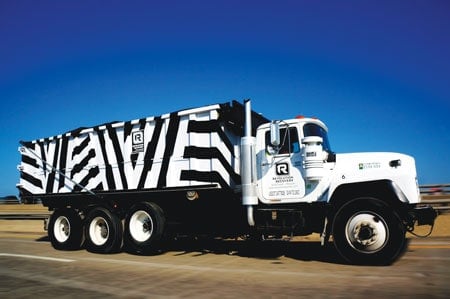
A Philadelphia native, Wybar graduated from the University of Texas at Austin in the Fall of 2001. The attacks of September 11th thwarted Wybar from getting a job in his field of Geology, but facilitated a job with a Philadelphia-based environmental firm working on the clean up at Ground Zero. “When I came back to Philadelphia with that company, my former business partner was talking to me about drywall recycling and it wasn’t working out with my old boss, so I decided to give it a go. I was 18 months out of college and had only had one serious job. If you told me in high school or college that I would own a recycling business in Northeast Philly, I would have thought you were out of your mind, but I love the tangibility of the business, seeing buildings go up, the recycling materials come in, our team, our vendors and our customers.”
Serving the greater Philadelphia area, Revolution Recovery operates a fleet of 28 trucks, and processes C&D material at their facilities in Philadelphia, PA, New Castle, DE and Allentown, PA. The company primarily handles C&D material, including dry waste, wood, drywall, cardboard, plastics, rubble, metal, ceiling tile, carpet, etc. However, they also receive a wide range of bulk materials from commercial, industrial, manufacturing and residential sources. Revolution Recovery cannot accept any material that is liquid, hazardous, food waste or e-waste.
A Fluctuating Market
While China’s National Sword ruling has not directly affected Revolution Recovery, the company has felt the fluctuation of the markets. “Carboard prices are lower, that is a factor, but I can’t put that all on the National Sword ruling. It is 2 percent of our total outbound, which is a lot of cardboard and a fair amount of cash. At one point we were selling it for $220 a ton, now it is $65 a ton. That decrease is a real number, but not the end of the world. Wood, ferrous metal, drywall—they account for orders of magnitude more volume in our outbound profile. Ferrous prices have been strong recently, with only a little bit of a downturn. While the National Sword has softened prices in some markets that we rely on, we did not experience nearly the blow it was to curbside recyclers. We did see a little bump,” says Wybar.
Wybar does point out that they change their involvement in a market based on rising and falling costs. When necessary, they may stop separating and sending out a specific recyclable material because the market price for the material cannot support the labor and equipment needed to process it. What actually has affected the company more in recent times was the drop in the price of a barrel of oil. “We used to recycle carpet, but we had to stop when the price of oil dropped in 2014. When virgin plastic pellets become the same price as recycled nylon pellets, no one is going to buy recycled. When the price of a barrel of oil drops and the virgin material price goes way down, recycled material just cannot compete. As a result, carpet recycling is very difficult on the East Coast.”
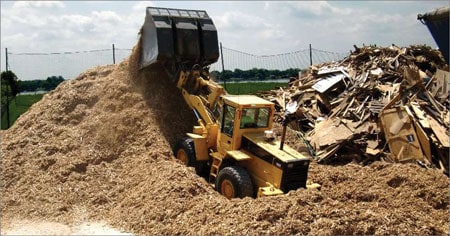
Another big challenge for Revolution Recovery was the influx of low-cost natural gas extracted from the Marcellus Shale, which crushed all the alternative energy moves in their region. The Marcellus Shale is a rock formation that extends throughout the northern Appalachian Basin and represents the largest source of natural gas in the U.S. This store of natural gas was left mostly untapped until 2005, when a cost-effective method for extracting the gas, hydraulically fracturing, was used successfully on a similar rock formation in Texas. As a result, the energy market was flooded with a cheap supply of natural gas, and renewable or alternative energy production became less financially feasible. “We were supplying the wood chips for boilers and cement kilns, etc. to a paper mill in Reading, PA, and they were consuming that as alternative fuel, powering their plant as well as selling it back to the grid. When the Marcellus Shale natural gas production spiked, it took the energy market so low that if you were a big consumer of energy, and you were considering putting in alternative fuel to power your process, you would scrap that and put in a natural gas line because it was cheaper. The Reading plant hung in there for a while but ended up putting their alternative fuel plant out of service. So, we currently have no alternative fuel outlet, which is unfortunate because that is the future, and we should be moving towards that,” says Wybar.
Wybar explains that the best thing happening for Revolution Recovery right now is the rising prices of the regional landfills. “The landfill price is your cost-avoidance price, so whatever we can’t recycle, we have to ship to the landfill. If the landfill price goes up $10 per ton, that adds $10 of value to everything we are pulling out. For example, mixed paper—if it cost us $70 to pull it out, bale it, and prep it for market, and we can only sell it for $50, we would still choose to recycle it because we are avoiding paying the landfill $50 to take it. We are competing with people who are just shipping it to the landfill, so if the landfill is expensive and recycled materials are valuable, they cannot compete with us. We recover about half of all the material we receive, and if our landfill price goes up, all that material that we diverted from the landfill waste stream realizes that increase. The waste industry should be innovating to develop optimum recycling and alternative energy processes and markets. Whereas today, we are forced to focused on landfill capacity. We face new waste challenges and we need to address them in new ways. Rising landfill prices is a baby push in the right direction.”
Once processed, each material is sent to a different outlet for secondary processing or manufacture. Revolution Recovery has identified more than 40 different local outlets for their recovered materials. For example, most of their recovered wood is sent to a mulch manufacturer. Drywall, on the other hand, is diverted to two streams in the agricultural sector: the paper lining is used as animal bedding while the gypsum is pulverized and used as a soil amendment. Revolution Recovery’s R&D team is constantly looking to improve and diversify the outlets for recovered materials so that they can continue diverting material from landfills, even as markets change. “Globally, we are facing a waste management crisis with significant environmental, social and economic consequences,” says Wybar. “At Revolution Recovery, we are positioning ourselves on the front line of solving these problems. We see it as our mission and our duty to seek new and innovative solutions.”
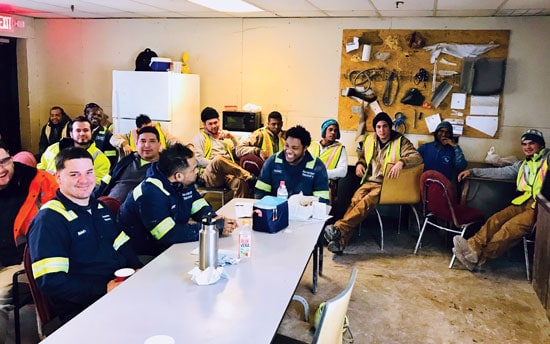
On the Job
At Revolution Recovery, when a potential new employee comes onboard, they go through a one-day orientation covering operations, safety ground rules, culture, etc. If they make it through and are hired, then a much more in-depth orientation is given for the particular job. For example, the operations side of the business covers the recycling plants, machine operations, labor, etc. while in the office, they have Revolution Academy, where the employees go out and learn about working in the shop and on the sort line. They also sit in on Accounting, Dispatch and Sales in order to understand the organization. “We have made a lot of progress in our training programs, but we are still working on optimizing them,” says Wybar.
Safety
Wybar points out that they also have a great safety record and program, thanks to their Safety Manager, Marlene Villca Poggian, who visits each individual site to ensure that they receive any needed support regarding safety. Villca Poggian states, “I am really proud of our Safety Department and all of my colleagues, they have embraced safety, made it their own and are helping change our culture to one that is safe and protects every employee. Also, they know that I don’t rest until safety is always put first. That’s what they call me The Hammer; I will hammer safety into you.”
In order to keep up-to-date on any changes or recalls, Villca Poggian uses resources and webinars from the Office of Environmental Health and Safety, the National Safety Council, and other safety-related publications and professional groups. At the beginning of every year, Villca Poggian does a walk-through at each facility, identifying hazards and safety-related needs in order to develop that year’s Safety Department plan. Villca Poggian also holds regular safety meetings at every site where she covers everything from lockout/tagout, their respiratory program, PPE, emergency action plans, fire safety, electrical safety, to topics that fit the season or situation. For example, in the summer, they cover heat-related illnesses, and with April being distracted driver awareness month, she focused on those dangers. They have also created their own forklift certification and are currently developing their operator certification for excavator or loader operators. Says Villca Poggian, “I have to make the meetings flexible for the drivers, so I’ll go all day into meetings and they’ll start on the hour, every hour. With the office safety meetings, I do them every six months because it is hard to bring all of management together, but that is when we do our fire drills, emergency training, etc. For the operations team, I do several meetings per year at each of our three facilities. Every meeting is catered to a specific department. Doing it this way is more efficient, because I can capture their attention better since it directly relates to what they do.” Villca Poggian also holds each safety meeting in three or four languages because the company has a very diverse group of employees. “I do them in English and Spanish and have an interpreter for the other languages. For example, in our Lehigh Valley facility alone, we have employees who speak Karen, a Burmese dialect and Tigrinya, an Eritrean language, as well as more common languages: Arabic, Spanish and French.”
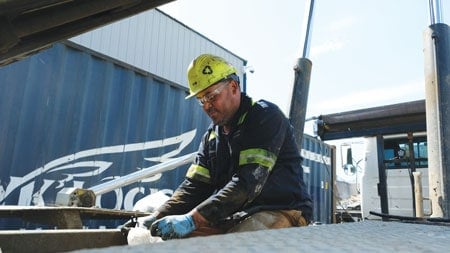
Villca Poggian explains that if an incident/near miss or accident not involving bodily injury does occur, they start by notifying her and the investigation begins with talking to those involved. “We write it up and take pictures and follow up with any training/review that is needed in order to ensure that the chances of an accident happening are reduced. If it’s an accident that involves bodily injury, we give them first aid or take them to Urgent Care or the ER if needed and afterwards we start the investigation. We always make sure that we attend to the employees, make sure they are ok, block off whatever has been the cause of the injury and make sure we notify others so it doesn’t happen again,” says Villca Poggian. “We are doing a lot of work on trying to be preventative rather than reactive. The managers and I hold safety rounds that cover things like how people are standing, are the paths clear, are exits blocked, was the operator going too fast, are they operating the machine correctly, do they have the correct PPE on, machine guarding, how clean and neat the work space is, are hoses in the right place and ready to be used, are eyewash stations stocked, etc. We talk about how to address these issues and others. We also have conference calls each month with managers to learn about what issues have happened and how it was addressed in order to learn from each other’s experiences. We also discuss safety catches and ensure those employees are praised.”
Maintenance
Revolution Recovery holds weekly maintenance meetings and their maintenance team does a great job with repairs, keeping up with inventory, and not letting things fall by the wayside. Wybar stresses that maintenance is a continuous process with a long list of things to inspect twice per day. “Maintenance is absolutely critical in the recycling business. There are so many moving parts. Our sort line in Philadelphia is 600 feet long and there are hundreds of components that could fail and take the whole thing down. If you are in that situation, you have to get creative and stockpile what you can. We plan different projects and we keep our guys working. We have a lot of real-time maintenance checks. If you are working on the line, you need to have a basic understanding of how everything works, so if you notice something off, you can report it to maintenance right away. At the end of the shift, there is an inspection and each individual is responsible for a certain section.”
Community Outreach
In addition to supporting a lot of charities and baseball teams, Revolution Recovery hosts networking associations and similar organizations at their sites. With an artists in residence program, Recycled Artists in Residency (RAIR), the company hosts rotating artists that incorporate waste material into their art pieces. “They go through and source all the stuff that is reclaimed. One artist, Carrie Mae Smith, built a boat out of salvaged material, and sailed it on the Delaware. Another artist pulled out all of the metal bales and built a stage and had metal bands play on that. One person made a costume for their horse. Artists have even painted some of our dumpsters, and they make the image for our holiday card every year,” says Wybar.
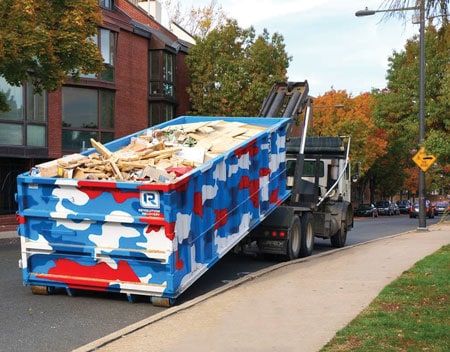
Focusing on R&D
Currently fortifying their position in the market, Revolution Recovery is playing defense, waiting for a break, or an opportunity to jump on new technologies. Explains Wybar, “Last year, we put money into the fleet and this year, our focus is on R&D: advancing recycling markets or making waste materials into other materials, plastic to diesel, etc. That is what the world needs—new innovations for this waste material and we want to take the lead. We keep a lot of materials out of landfills, but we want to divert even more, put that material into recycling markets and create more jobs. We like seeing solutions like plastic-to-fuel and biochar, but you have to build these markets.”
Meanwhile, Wybar says he is most proud of the development of their team and loves to watch new employees come into the company who have no experience and no skill, right out of high school or newly located to the country to learn the safety skills and the business and watch them become skilled machine operators or tradesmen. “We have a very diverse workforce and I am proud of our team development, seeing how people have progressed and gained skill and experience over time.”
For more information, call (215) 333-6506, e-mail [email protected] or visit www.revolutionrecovery.com.
